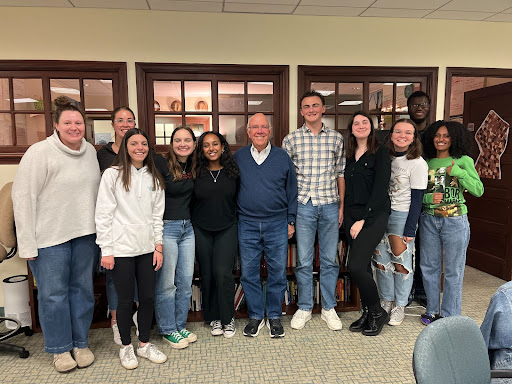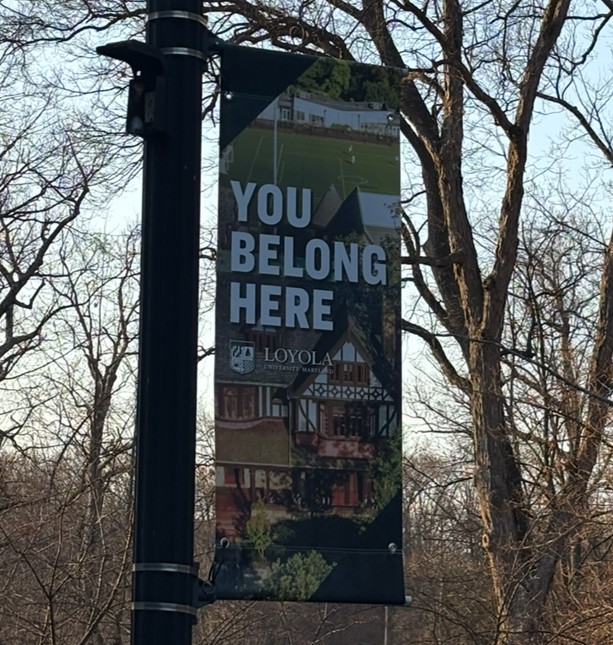David Hornbeck, founder of Restorative Schools Maryland, paid a visit to the Center for Community, Service, and Justice (CCSJ) on Nov. 6, where he met with Loyola’s circle of 10. Circles of 10 are small advocacy groups throughout Maryland who write monthly letters to the state general assembly urging them to pass legislation to implement restorative practices in public schools. Hornbeck, a veteran in the field with over 57 years of experience in education, discussed what restorative practices are, what issues in schools the practices address, and why he believes they are necessary.
The definition of restorative practices provided on Restorative Schools Maryland’s website is “a suite of learned skills which, when implemented in a school or community environment, strengthen bonds between individuals and social connections within communities, and also reduce harm, conflict, and violence in and outside of school.”
In practice, Hornbeck described restorative practices as more expansive than this definition. It includes conflict resolution through the victim and perpetrator being brought together to discuss what happened with a neutral party, which is called a “circle.”
Restorative practices include accountability, but accountability is established from a constructive conversation built on trust and respect. This conversation asks both parties involved in the conflict: what happened, how did it affect you, what should we do to move ahead, and what should the consequences be? The result is based on a reparative framework, rather than punishment. Hornbeck seeks to develop this healing mindset.
It is also about the culture of the school. Hornbeck sees restorative practices as going far beyond bad behavior—it is about framing the culture of a school in a way that bad behavior is prevented before the bad behavior even begins.
“We focus a lot on community building [within the schools]. The point of community building is a relationship where we all get to know each other more and differently than we have before. It is not something that happens overnight, but community building towards a culture and climate where relationships and trust, hearing each other’s voices, and accepting accountability of each other’s actions becomes the mindset. The new way of life, so to speak,” Hornbeck said.
He described his first encounter with restorative practices, which was at Hampstead Hill Academy in Baltimore City, a restorative school where his son Matt Hornbeck is principal. Hornbeck said that one day, about 10 to 12 years ago, he was talking with his son in the hallway, when a 7-year-old girl ran up, insisting she spoke to Principal Hornbeck right away. The girl said, “If I don’t get a circle in the next 10 minutes, I’m going to hit him,” in response to a classmate provoking her.
“Two things about that impressed me. One was that the 7-year-old girl knew that there was an alternative to hitting him. That hadn’t come because she took a test about ‘what’s an alternative to hitting,’ it came to her because that’s the way she was treated in the school. She knew that’s the way you approach life under those circumstances,” Hornbeck said.
He was also impressed because the girl knew that if she reached the highest authority in the school, then he would support her, have her back, and not reprimand her. Hornbeck’s son believes, which he now does too, that restorative practices are not only for the benefit of the children. Restorative practices are possibly even more about the adults in the school than they are about the kids.
“If adults treat each other right and if adults treat kids right, the likelihood that the kids are going to treat each other and the adults right skyrockets,” Hornbeck said.
Hornbeck described five areas Restorative Schools Maryland has identified as the main issues that restorative practices would alleviate, which is supported by scholarly research.
The first is suspension and school arrests, or what is known as the school to prison pipeline. There were 56,000 suspensions in Maryland last year. Of those suspensions, 60% were black students and 27% were students with disabilities. Research shows that suspension is one of the most significant indicators that a child will end up not graduating, with a criminal record, or in a correctional institution. Hornbeck cites the current exclusionary practices in schools as where this cycle begins.
When the school police officers in Baltimore were trained in restorative practices, within the next five years school arrests dropped by 81%.
The second issue that restorative practices would reduce is chronic student absenteeism. Last year, 22.4% of children in Maryland were chronically absent, which means they were not in school for 10% or more of the year. Restorative practices would improve the school environment so that children feel welcomed, appreciated, and respected, which Hornbeck said will make them more inclined to come to school.
The third issue is teacher turnover. In Maryland, 14% of new teachers leave before the end of their third year and 10% (6,000 teachers) leave each year. This limits experienced faculty, which improves student achievement, and also has financial implications, as it costs $9,000 to $21,000 to replace a teacher who leaves the system.
“Why do teachers leave? If you went up to five teachers and said ‘what’s your biggest problem,’ classroom management will always be in the top two or three. It is almost rarely ‘I’m paid too little’. It is mostly about culture, how one is treated. It’s about colleagues and relationships,” Hornbeck said.
Mental health is the fourth issue, which has skyrocketed since the pandemic. Last year, research revealed that 29% of high school students and 23% of middle school students in Maryland said that they were sad or unhappy “most of or all of the time.”
The fifth and final issue is the achievement gap, which is the result of all the other issues. For example, if a child gets suspended frequently, does not show up to school often, or has an inexperienced teacher, they are less likely to perform well and it widens the achievement gap.
Hornbeck cited that 34% of Black children in grades three through eight are proficient in English Language Arts, as opposed to 67% of white children. In math, 40% of white children are proficient, while 12% of Black children are.
He emphasized that these numbers—suspension, achievement, absenteeism, mental health, teacher turnover—are unacceptable and unnecessary. Restorative Schools Maryland is addressing the unnecessary aspect of the problem, through pressuring the general assembly to pass legislation that ensures staffing and training will be provided to begin creating more restorative schools over the next 10 years.
This month, Restorative Schools Maryland and circles of 10 throughout the state are writing letters to Bill Ferguson, Maryland Senate President and Adrienne Jones, Maryland House Speaker urging them to pass this legislation.
“I happen to believe that education is the fulcrum of our life together. There are lots of important things to be done, whether it’s health or housing or employment or a whole bunch of things. I’ve always thought of education as being at the center, and if you got that right, it would impact the health, housing, employment, and all the other things in the kinds of positive ways we think should be done,” Hornbeck said.
To learn more about Restorative Schools Maryland, visit their website. To join the circle of 10 at Loyola, contact Abbie Flanagan, Assistant Director for Outreach and Advocacy at CCSJ, at aflanagan1@loyola.edu.















































































































Jacki • Nov 18, 2023 at 9:12 am
Bravo Gianna, well written, easy to understand and for the future of society it would be nice for this article to be published so many cities and schools have the opportunity to read !